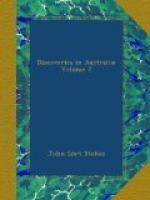SUGGESTED ROUTE.
I have before recommended the use of camels, with skins for carrying water, in an undertaking of this kind; and I may here add, that they might be procured in the neighbourhood of the Gulf of Cutch,* which place the vessel should leave in the North-East monsoon, in time to have the latter end of the North-West monsoon to take her to the Gulf of Carpentaria, where at Sweers Island the final arrangements for disembarking, before alluded to,** could be made.
(Footnote. Camels are to be procured in this neighbourhood, when they are not required for war service, for about five pounds a head. Besides, the natives of that part are more easily to be obtained as attendants than Arabs.
(Footnote. See above.)
In a country like Australia, with so varied a surface, it is certainly impossible to indicate with confidence anything beyond the point of departure for an exploring party. Their direction must, of course, depend on the country they find; but I think it may be said from the most recent, and I much fear melancholy, experience, that the routes from neither Moreton Bay nor Fort Bourke are practicable. That from the head of the Albert is, I believe, much superior, and I consider, after mature deliberation, that the plan I have recommended is at once the most expeditious and the most economical way of solving a question of daily increasing interest, and of removing an imputation on English enterprise which is daily becoming more serious.
The other routes of exploration which appear to me both practicable and useful are from Halifax Bay to the Albert,* a distance of above four hundred miles, and from Limmens Bight to the Victoria, about three hundred. These will be found marked in the chart accompanying this work.
(Footnote. This route I suggested to his Excellency Sir George Gipps, in March, 1842.)
TWOFOLD BAY.
After leaving Sydney we had a succession of south-easterly gales, of three or four days’ duration, and equal in severity to any we had experienced since leaving England. To avoid one from the westward we put into Twofold Bay;* a remarkable high-peaked hill, Mount Imlay, lying behind the head of it, bearing South-West 1/2 West, leads in.
(Footnote. This we found to be a very convenient anchorage; and the constant resort of coasters. From its proximity to the southern parts of the Manero country, it is likely to become a very thriving place, under the auspices of Mr. Boyd, who is erecting a town there. This gentleman, I am happy to say, employs the natives as part of the crew of his yacht; they are also constantly engaged in the boats of the whaling station, where their excellent eye renders them extremely useful in seeing and harpooning the fish; and being particularly well-disposed, they might he made something of.)
I was surprised to find by my observations* here that this part of the coast is laid down ten miles too much to the eastward of Sydney, an error I subsequently found to be continued to Jervis Bay; so that the course from thence to Sydney, instead of being, according to the chart, North 1/4 East magnetic is North by East, a fact that should be borne in mind by masters of vessels, until this part of the coast is properly surveyed.




